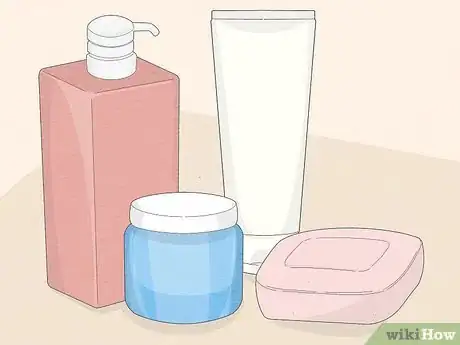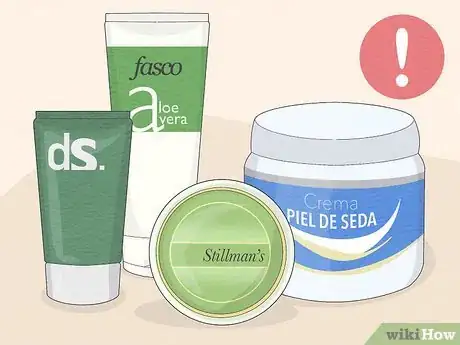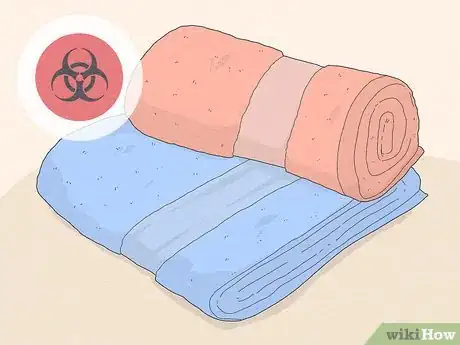This article was medically reviewed by Luba Lee, FNP-BC, MS. Luba Lee, FNP-BC is a Board-Certified Family Nurse Practitioner (FNP) and educator in Tennessee with over a decade of clinical experience. Luba has certifications in Pediatric Advanced Life Support (PALS), Emergency Medicine, Advanced Cardiac Life Support (ACLS), Team Building, and Critical Care Nursing. She received her Master of Science in Nursing (MSN) from the University of Tennessee in 2006.
This article has been viewed 42,731 times.
Mercury is a metal that is poisonous to humans in any form. Poisoning can occur through ingestion, injection and absorption through the skin. People have used mercury for centuries in different medications and consumer products.[1] One common product containing mercury is skin care. Anti-aging, blemish correcting, and skin lightening or whitening products are the most likely to have mercury, especially in unsafe doses.[2] Using skin care with mercury is not only dangerous for you, but also for anyone who may touch your skin or be close enough to breathe any fumes. You can avoid mercury in skin care by identifying it in products and taking additional precautions.
Steps
Identifying Mercury in Skin Care Products
-
1Recognize common products that use mercury. There may be mercury lurking in many of your skin care products. However, some are more likely to contain it. Check any of the following to see if they contain mercury:[3]
- Skin creams, especially anti-aging and skin lightening
- Beauty and antiseptic soaps
- Lotions
-
2Read the product label for mercury synonyms. Since mercury doesn't have a distinctive smell or color, the only way to tell if it is in a product is to read the labeling. In the US, all cosmetic products are required to list their ingredients. Skin care containing mercury is often marketed as anti-aging and/or lightening or whitening.[4] Look for the word “mercury” or any of the following synonyms for it on your product’s label:[5]
- Calomel
- Mercurous chloride
- Mercuric
- Mercurio
Advertisement -
3Steer clear of products without a proper ingredients label. Most countries require that products within their borders contain a label. This can ensure that the product is regulated and won’t pose any harm to the consumer. If your products have no label or one in a language you don’t understand, avoid purchasing or using it. This can minimize your and other people’s risk of exposure to mercury.[6]
- Make sure any labeling is clearly written in a language that you understand. Don’t rely on other people or online translators to decode a product label that may have mercury in it.
- Stay away from products that do not list a country of origin.
- Recognize that products without a label may be illegally marketed.
-
4Watch out for specific skin care product brands. In the United States, the Food and Drug Administration has identified specific skin care product brands that contain excessive mercury. Try and avoid products from the following brands:[7]
- Diana
- Fasco
- Stillman’s
- Crema Piel De Seda (Silky Skin Cream)[8]
Taking Additional Precautions to Avoid Mercury
-
1Be wary of imported or foreign products. When buying your skin care, use caution if you’re considering an imported product. You should also watch for mercury if you’re traveling and want to try foreign skin care. Local regulations may not require testing for mercury.
- Use caution with products, even if a person tells you they’re “safe.” Anything without a label or written in a language you don’t understand may contain mercury.
- Skin lightening products from Africa or the Caribbean are more likely to contain mercury.[9]
-
2Locate places most likely to sell products with mercury. Certain retailers are more likely to sell skin care products containing mercury. Knowing what types of places may sell these product can help you avoid purchasing potentially harmful skin care. These locations include:[10]
- Grocery stores
- Ethnic markets, particularly one with Asian, African, Middle Eastern, or Latino customers
- Social media sites
- Mobile apps
-
3Toss the product properly. If you are using or suspect that you may have skin care containing mercury, stop using it immediately. You need to get rid of the product with a local waste company or trash collection because mercury is considered “hazardous waste.” Collect any products containing mercury in a sealed container and take it to your local hazardous waste facility.[11]
- Get rid of any products about which you may be unsure. It’s better to be safe than sorry.
-
4Get rid of potentially contaminated textiles. Your family can breathe in mercury vapors if you have a product on your skin with it. But textiles such as washcloths and towel may also present a risk of exposure to mercury. Put any textiles you have used in a sealed container and take to the local hazardous waste collector along with the products themselves.[12]
- Recognize that it may be expensive to replace textiles exposed to your skin care products. However, it is cheaper than dealing with medical bills from mercury poisoning or toxicity.
Warnings
- Mercury absorbs easily through the skin, but you do not need to touch or come in contact with mercury for it to be harmful.⧼thumbs_response⧽
- Be aware that using a skin care product containing mercury while pregnant or nursing can increase your child’s risk of mercury toxicity.[14]⧼thumbs_response⧽
- Call your doctor or the National Poison Control Center at 1-800-222-1222 immediately if you show signs of mercury poisoning. Symptoms include drowsiness, fatigue, hair loss, inflamed gums, insomnia, irritability, memory loss, rash, tingling of the extremities, tremors, and weakness.[15]⧼thumbs_response⧽
References
- ↑ http://emedicine.medscape.com/article/1175560-overview#a3
- ↑ http://www.consumerreports.org/beauty-personal-care/avoiding-mercury-poisoning-from-skin-care-products/
- ↑ http://www.fda.gov/ForConsumers/ConsumerUpdates/ucm294849.htm
- ↑ http://www.fda.gov/ForConsumers/ConsumerUpdates/ucm294849.htm
- ↑ http://www.consumerreports.org/beauty-personal-care/avoiding-mercury-poisoning-from-skin-care-products/
- ↑ http://www.consumerreports.org/beauty-personal-care/avoiding-mercury-poisoning-from-skin-care-products/
- ↑ https://www.womenshealth.northwestern.edu/blog/fda-warns-mercury-skin-cream
- ↑ http://www.consumerreports.org/beauty-personal-care/avoiding-mercury-poisoning-from-skin-care-products/
- ↑ http://www.consumerreports.org/beauty-personal-care/avoiding-mercury-poisoning-from-skin-care-products/
- ↑ http://www.fda.gov/ForConsumers/ConsumerUpdates/ucm294849.htm
- ↑ http://www.consumerreports.org/beauty-personal-care/avoiding-mercury-poisoning-from-skin-care-products/
- ↑ http://www.fda.gov/ForConsumers/ConsumerUpdates/ucm294849.htm
- ↑ http://www.fda.gov/cosmetics/complianceenforcement/adverseeventreporting/default.htm
- ↑ http://www.fda.gov/ForConsumers/ConsumerUpdates/ucm294849.htm
- ↑ http://www.consumerreports.org/beauty-personal-care/avoiding-mercury-poisoning-from-skin-care-products/



































































